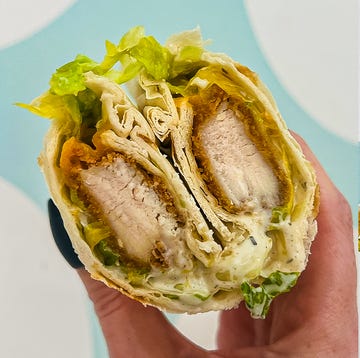First thing's first: What even is a gallbladder?! If you haven't gone to science class in a while, it's an organ that stores and releases bile into the small intestine, helping you absorb the nutrients in food. But if your gallbladder has too much bile, the digestive fluid can harden into little lumps called gallstones.
Some risk factors for this potentially painful condition stem from what you eat. Obesity, significant and rapid weight change and a diet high in ultra-processed foods can up your chances. You're also at risk for cholelithiasis — another name for gallstones — if you're a woman or have a family history of it.
Plenty of people have gallstones and get off scot-free, but once symptoms like abdominal pain, fever, nausea and vomiting occur, it's likely you'll have your gallbladder removed in a cholecystectomy. While you don't actually need your gallbladder, you can still make manageable changes to help avoid potential pain and surgery. Here's how to stay on the right track:
What to Avoid
Check in with your doc to see if you fall in the at-risk category. If you're obese, the first line of defense is sustainable weight loss. Crash dieting will only up your odds even more. Maintaining a healthy weight keeps you in fighting shape, and reduces your risk of other chronic diseases, like heart disease, diabetes and certain cancers.
Next, aim to cut back on food sources high in saturated fat and added sugar, including fried foods, candy, baked goods, sugary beverages, butter, red and processed meat and greasy fast food. Check labels for sneaky sweeteners hidden in things like yogurt, granola and even bread, and try to avoid partially hydrogenated oils entirely.
What to Eat
As for what you should eat, research supports following a more plant-based, Mediterranean-style diet. It's filled with fiber and low in saturated fat and added sugar. The menu's also chock-full of antioxidants, B vitamins, fiber, calcium, potassium and magnesium, which can also reduce your risk of gallstones and other diseases.
Since chronic dehydration may also up your odds, drinking lots of water can also help. Luckily, staying hydrated can also include moderate alcohol consumption! Research has linked drinking wine regularly (one glass per day for women, two for men) with a reduced risk of gallstones. You should also swap sugary beverages like juice and soda for sparkling water, unsweetened tea and coffee and regular H2O.
Add these other green-lit foods to your grocery list as well:
- Veggies and fruit (of all kinds — the more the merrier!)
- 100% whole grains: wheat, oats, bulgur, buckwheat, rye, millet, sorghum and amaranth
- Pulses and legumes: beans, lentils, chickpeas and peas
As for protein and better-for-you fats, your best bets include:
- Lean poultry, pork and cuts of beef, like top or bottom round
- Seafood
- Tofu
- Low-fat dairy products and eggs
- Cooking oils: canola, olive, hemp seed, walnut, avocado and soybean
- Nuts and seeds: peanuts, almonds, cashews, pistachios, pecans, walnuts, chia, hemp and ground flaxseed
Keep in mind: The healthiest eating plans don't include deprivation. Constantly limiting yourself can only backfire in the long term, making it more likely you'll develop gallstones! Indulging in something decadent (about 200 calories) daily can help you stay satisfied and stave off the urge to go head first into the brownie pan!
Follow Delish on Instagram.
Download the Delish app.













